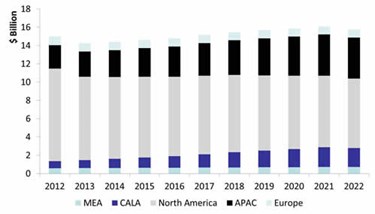Military Radar System Spending Approaching $16B In 2022 Says Strategy Analytics

Military radar shipments growing at a CAGR of 5.4 percent
The emergence of new platforms, retrofitting existing platforms with new technologies as well as general maintenance of systems across land, air and naval domains will lead to military radar spending approaching $16B in 2022. The Strategy Analytics Advanced Defense Systems (ADS) service series of forecasts, outline global defense expenditure trends segmented on a regional basis before breaking out the expected spend on military radar incorporating systems, hardware, support and related services across the land, air and naval domains.
- Despite budgetary constraints, the North American region, led by the US, will drive the bulk of expenditure accounting for over 48 percent of global military radar spend.
- Asia-Pacific military radar spending will be driven by internal capability development as well as acquisition of platforms and radar systems to maintain competencies against both regional and international challenges.
The Land-based Radar Systems and Components Forecast 2012-2022, Shipborne Radar Systems and Components Forecast 2012-2022 and Airborne Radar Systems and Components Forecast 2012-2022 series of forecasts also detail radar shipments segments across various platforms and the associated market for electronic components.
"Military radar systems shipments will exceed 900 units by 2022 across land, airborne and ship-based systems," notes Eric Higham, North American Director for ADS. "Demand from airborne platforms will dominate overall unit demand reflecting the overall trends of system demand from emerging platforms such as the F-35, as well as upgrading existing platforms with new radar capabilities."
"The associated market for electronic components will grow at a CAGR of over 13 percent, with the move towards active electronically scanned array (AESA) radar in particular underpinning next generation capabilities," predicts Asif Anwar, Director at Strategy Analytics. "This will continue the drive towards radar systems underpinned by semiconductor technologies such as gallium nitride (GaN) though tube-based solutions will continue to support legacy systems, as well as being used in those cases where the capabilities offered by AESA-based systems are either not required or prove too costly for the required mission."
Strategy Analytics will be showcasing these latest military RADAR forecasts with samples in the forthcoming webinar, Market Outlook for Military Radar.
Click here to register: https://www.strategyanalytics.com/default.aspx?mod=EventDetails&a0=924242&s=3
Source: Strategy Analytics
